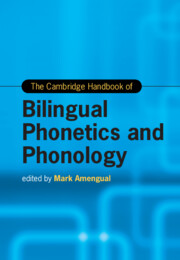Book contents
- The Cambridge Handbook of Bilingual Phonetics and Phonology
- Cambridge Handbooks in Language and Linguistics
- The Cambridge Handbook of Bilingual Phonetics and Phonology
- Copyright page
- Dedication
- Contents
- Figures
- Tables
- Contributors
- Acknowledgments
- Introduction Bilingual Phonetics and Phonology
- Part I Approaches to Bilingual Phonetics and Phonology
- 1 Generative Approaches to Bilingual Phonetics and Phonology
- 2 Usage-Based Approaches to Bilingual Phonetics and Phonology
- 3 Sociolinguistic Approaches to Bilingual Phonetics and Phonology
- 4 Psycholinguistic Approaches to Bilingual Phonetics and Phonology
- 5 Neurolinguistic Approaches to Bilingual Phonetics and Phonology
- 6 Computational Approaches to Bilingual Phonetics and Phonology
- Part II Theoretical Models of Bilingual Phonetics and Phonology
- Part III The Phonetics and Phonology of the Bilingual Child
- Part IV The Phonetics and Phonology of the Bilingual Adult
- Part V The Diversity of Bilingual Speakers
- Part VI Variables and Outcomes of Bilingual Speech
- Index
- References
5 - Neurolinguistic Approaches to Bilingual Phonetics and Phonology
from Part I - Approaches to Bilingual Phonetics and Phonology
Published online by Cambridge University Press: 14 November 2024
- The Cambridge Handbook of Bilingual Phonetics and Phonology
- Cambridge Handbooks in Language and Linguistics
- The Cambridge Handbook of Bilingual Phonetics and Phonology
- Copyright page
- Dedication
- Contents
- Figures
- Tables
- Contributors
- Acknowledgments
- Introduction Bilingual Phonetics and Phonology
- Part I Approaches to Bilingual Phonetics and Phonology
- 1 Generative Approaches to Bilingual Phonetics and Phonology
- 2 Usage-Based Approaches to Bilingual Phonetics and Phonology
- 3 Sociolinguistic Approaches to Bilingual Phonetics and Phonology
- 4 Psycholinguistic Approaches to Bilingual Phonetics and Phonology
- 5 Neurolinguistic Approaches to Bilingual Phonetics and Phonology
- 6 Computational Approaches to Bilingual Phonetics and Phonology
- Part II Theoretical Models of Bilingual Phonetics and Phonology
- Part III The Phonetics and Phonology of the Bilingual Child
- Part IV The Phonetics and Phonology of the Bilingual Adult
- Part V The Diversity of Bilingual Speakers
- Part VI Variables and Outcomes of Bilingual Speech
- Index
- References
Summary
This chapter provides a cross-sectional overview of current neuroimaging techniques and signals used to investigate the processing of linguistically relevant speech units in the bilingual brain. These techniques are reviewed in the light of important contributions to the understanding of perceptual and production processes in different bilingual populations. The chapter is structured as follows. First, we discuss several non-invasive technologies that provide unique insights in the study of bilingual phonetics and phonology. This introductory section is followed by a brief review of the key brain regions and pathways that support the perception and production of speech units. Next, we discuss the neuromodulatory effects of different bilingual experiences on these brain regions from shorter to longer neural latencies and timescales. As we will show, bilingualism can significantly alter the time course, strength, and nature of the neural responses to speech, when compared with monolinguals.
Keywords
- Type
- Chapter
- Information
- The Cambridge Handbook of Bilingual Phonetics and Phonology , pp. 104 - 125Publisher: Cambridge University PressPrint publication year: 2024

